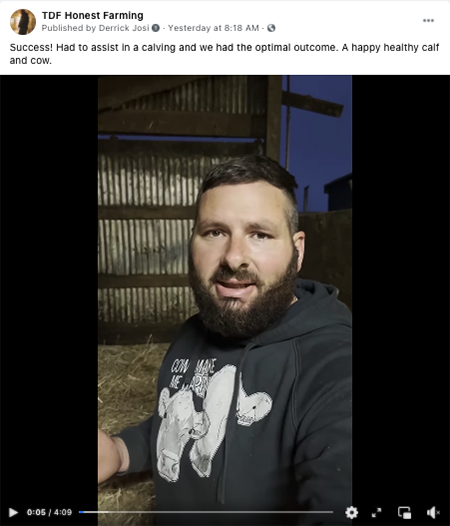Video doesn’t have to be a complicated effort with a professional film crew, script writing, and high-end editing production to effectively share your farm’s story. In fact, those things might hurt a video. Consumers want authenticity, transparency, and behind-the-scenes shooting, especially when it comes to filming on your farm.
People want to see the animals. They want to see the big equipment and farm life. People love the wide-open spaces. Remember, most of our consumers are dwelling in cities and urban areas.

Something else that will never change is the best videos are entertaining, relevant, and useful. Make people laugh. Make them cry. Help them learn something. It's a lot easier to help people if you are enjoying the video process as well.
If you decide to use video of your farm, here are some tips I recommend:
1. Three seconds to scroll
Start with the action right away because people have very short attention spans (three seconds). If it doesn’t interest them immediately, they will scroll past your video.
2. Depending on the platform you like to use is how you will shoot the video.
If you are sharing on Facebook, Instagram, or TikTok, then shoot vertically. People love vertical video now because the platforms allow you to do some cool editing to vertical video (especially in stories).
3. If your hand and arm is stable, then you can use it.
If not, maybe get a tripod or something that locks the phone down. Try not to move too fast. Pan around and move slowly. It won’t bother the viewer as much.
4. Lighting is important.
Try to record in a lighted area that is not in direct sunlight, so you aren’t squinting. If it's in the dark, try and get some light behind you and what you are recording.
5. Audio makes a difference.
If people can't hear you, then they will struggle with paying attention to what you are saying. A good microphone can be your phone headphones. Wired is usually better, but they can get in the way.
6. Automate closed captioning on the platforms.
Eighty to 90% of people don’t have the sound on because they are watching in a place where the volume needs to be off. Closed-caption video allows users to read what you are saying.
7. It’s more important to have authentic surroundings.
I would worry more about getting the scene to match what you are talking about. I would also say that animals still outrank people for interest (and the chance they could do something funny is pretty high), so film them and talk about your cow care. Don’t shoot yourself or anyone else against a wall or shadowed background.
8. You don't need B-roll if the scenery is interesting.
People don’t want to just look at one thing for very long. Next time you catch the news, watch how many times the segment cuts to a person on the scene or includes B-roll to help keep your attention.
9. Unless you have a phone with different cameras for zoom, don't use it.
Digital zoom is grainy and can distract from what you are trying to record. Just get up close if you can.
10. Practice, practice, practice!
The more you do, the better you'll get. Play with different shots and edits. You will improve at filming and video editing, and companies are constantly making the software applications better. Things that used to take days in video control rooms can be done in minutes with a phone app. You can always delete what you’ve done and try it again.
My two favorite video editing apps are Video Show and iMovie. Instagram's Stories has a lot of features. All are easy to use, but Video Show has become costlier. I would also recommend inShot, and the video editing abilities of Instagram, Facebook, and YouTube are much, much better.
When it comes to copyright, you own the video if you shot the video. If you want to put your logo on the video, most video apps have a way to do a logo overlay if you have your logo saved as a PNG, JPG or GIF file.
If you film the public on your farm (during a dairy farm tour or dairy breakfast, for example), you should get a release from everyone who might be in the video (including parents of kids – schools usually cover this, but you should ask if not sure). Your local dairy checkoff usually has these releases, and I recommend reaching out to them if you need one.
Remember, if you need more video help, please reach out to your local dairy checkoff to find out what resources they offer to help farmers with digital promotion.
To learn more about your national and local dairy checkoffs, visit www.USDairy.com or send a request to join our Dairy Checkoff Facebook group.

The author is a Senior Vice President of Digital Initiatives at Dairy Management Inc.